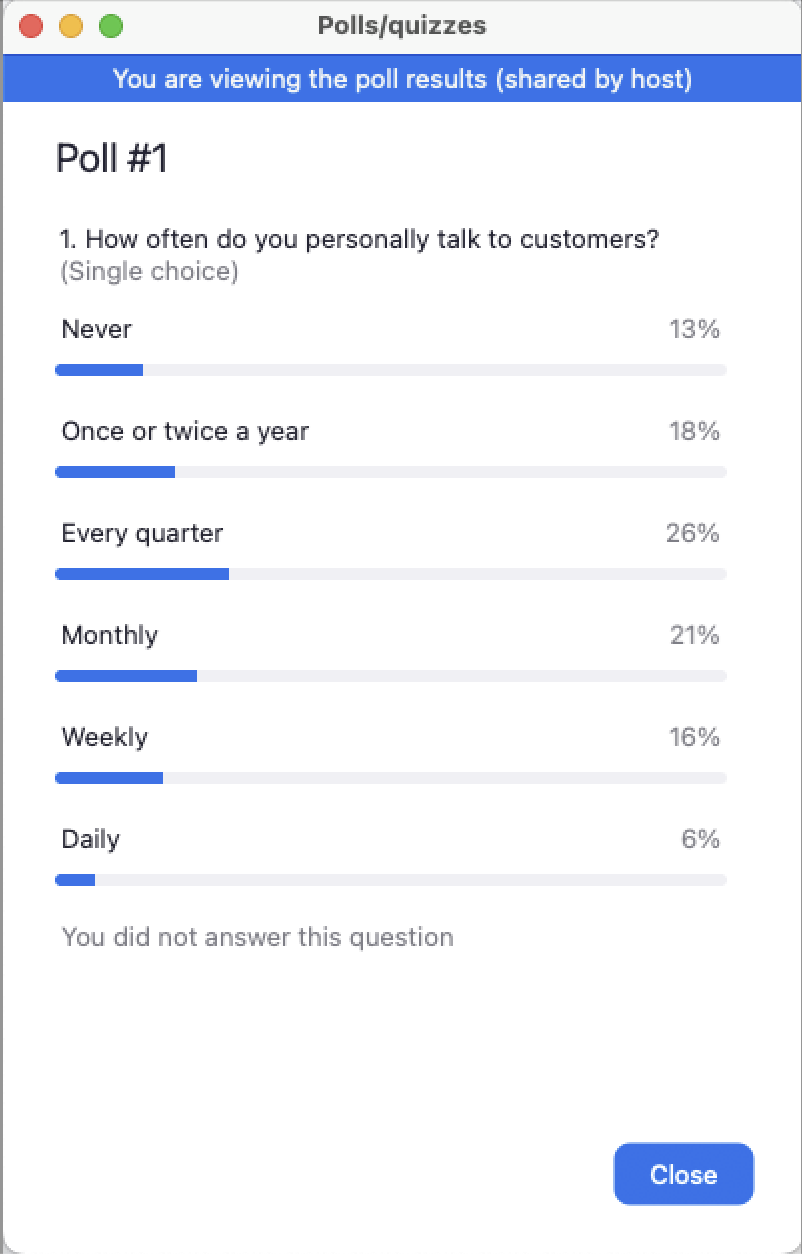Poor usability is not only frustrating for users but also has a direct impact on revenue. According to this report, 60% of consumers regularly abandon purchases due to a poor website user experience, with businesses estimating an average loss of $72,000 USD per year in missed sales.
These figures highlight a critical reality: proper UX is no longer a “nice-to-have.” But, while many companies recognize its tangible value, many still fail to conduct user testing in a timely manner, often postponing it until after a product has been launched, increasing the risk of failure and costly rework. In other cases, user testing is tapped into sporadically, leaving critical gaps in user feedback and hence, product improvement.
Today’s most successful companies know that truly understanding their customers will directly impact their analytics and dashboards. And it’s only through iterative user feedback that companies can build user-centric products that deliver results.
When regular UX research is embedded into the product lifecycle, teams can iterate faster, reduce wasted resources, launch with confidence, and evolve as needed, transforming UX from a design task into a strategic lever for growth.
What is User Testing and How Often Should Companies Perform UX Research?
User testing, also known as usability testing, is a method used in user-centered design to evaluate a product by testing it with representative users. This process provides direct input on how real users interact with your product or prototype, helping identify usability issues and areas for improvement.
Regularly conducting user testing is essential to creating a seamless user experience, and it should ideally occur every time a change is made, whether that’s a modification to your website, a prototype update, or any other stage of product development. In other words, user testing should ideally occur during each phase of ideation and prototyping to gather fresh insights and ensure you’re meeting user expectations.
Every time you run a study with a new prototype or website iteration, you’ll gain valuable insights tied specifically to the changes made. This allows teams to continuously refine their product and ensure that it resonates with the target audience.
However, it’s important to recognize that most testing should be tied to new developments. If your team lacks the resources to frequently create prototypes or make significant changes, the testing frequency may be limited.
Our recommendation is that testing happens frequently, as it provides the opportunity to gather user feedback early and often. Balancing this approach with the available resources at hand will be the key to maintaining a practical testing schedule.
Common Roadblocks to Frequent User Testing
While regular testing can lead to more informed decisions, improved user experiences, and long-term savings, many companies only conduct user research a few times a year. In fact, a recent poll we conducted revealed that one third of respondents rarely or never talk to customers, meaning key decisions are being made without meaningful user input. This disconnect can lead to products or services that simply miss the mark.

Resources
One of the main reasons for limited user testing often boils down to limited resources. While companies recognize the value of user testing, many don’t have the internal team to consistently run research or act on the insights gathered.
In many cases, there’s a gap between collecting data and implementing the necessary changes in the sense that an organization might have the research team, but not the development team to translate insights into actionable prototypes or updates.
Without the ability to make changes based on research in a timely manner, testing can feel like a waste of time and money. In this way, this cycle can leave companies reluctant to test more frequently.
Time
Another barrier is time. Both the research and development teams may already be stretched thin, leaving little room for regular user testing.
Additionally, some organizations still struggle to see the long-term value of UX research, even if individual team members advocate for it. This disconnect often means that testing is only prioritized when immediate, visible outcomes are expected.
3 Easy Ways to Overcome UX Research Roadblocks
1. Start with Small UX Studies
One way to effectively overcome these challenges is to start small. Many of our clients begin with smaller, more focused studies that they can take back to stakeholders to demonstrate the impact of their findings.
Showing how a small change, informed by research, leads to tangible improvements in the user experience can help prove the value of ongoing testing. Over time, these small wins build a case for investing more in UX research, ultimately leading to greater efficiency and cost savings in the long run.
2. Leverage Third-party Usability Tools
For teams struggling with bandwidth, tools like the AI UX Analysis and the ULX Benchmarking Score can dramatically reduce the time and energy required to extract insights.
An AI-powered UX analysis tool can generate insights from qualitative video-based sessions helping eliminate the need to spend hours watching recordings manually, while the ULX Benchmarking Score provides an at-a-glance comparison of user experience performance across studies and competitors. These solutions enable teams to launch and analyze more sessions, more often, even with limited internal resources.
3. Tap into an External UX Team
Partnering with an external UX consulting team is an excellent way to expedite UX research, with the added bonus of accessing seasoned professionals who provide expert guidance, help set up studies, interpret results, and ensure that the user insights gathered are translated into meaningful improvements.
Together, these solutions can help organizations overcome common roadblocks to user testing and get the full value of continuous user testing.
Why Diversifying Research Methods is Key to Unlocking Deeper Insights in UX Research
When it comes to user research, relying on a single methodology can lead to biased data and incomplete insights. To truly understand your users, it’s essential to diversify your research methods, combining both qualitative and quantitative approaches. This helps capture a broader range of feedback and ensures you’re not missing any critical information.
For instance, combining moderated studies with A/B testing or integrating rating questions into qualitative research like unmoderated interviews allows for a more well-rounded perspective on user behavior. This combination provides deeper insights into not just what users are doing, but also why they’re doing it.
Since user behavior is both subjective and complex, using multiple methods allows you to capture different angles of the user experience. By blending these approaches, you can uncover patterns that provide a more accurate, comprehensive view of how your product is being perceived and interacted with.
Ultimately, diversifying research methods helps you make informed decisions that are rooted in a holistic understanding of your users’ needs and behaviors.
How to Measure the ROI of UX Research
Measuring the ROI of UX research requires a strategic approach that aligns user insights with your organization’s key performance indicators (KPIs). As detailed in this whitepaper, the return on investment is determined by comparing the costs of conducting UX research against the tangible benefits realized through improved KPIs.
These benefits often include reduced project management hours, decreased development and quality assurance rework, fewer customer service interactions, and enhanced metrics such as Net Promoter Score (NPS) and System Usability Scale (SUS) scores.
For organizations still questioning the value of UX, it’s imperative for UX professionals to consistently link research findings to their defined KPIs. By doing so, they can demonstrate how UX research contributes to operational efficiencies and improved user satisfaction, thereby making a compelling case for ongoing investment in user-centered design practices.
Beyond internal benefits, it is worth noting that most venture capital and private equity firms, as well as corporate development teams, now consider excellent UX a core prerequisite for investment and a critical element of due diligence. Strong UX signals product maturity, customer focus, and scalability, all of which increase a company’s attractiveness to investors.
5 Ways to Measure the ROI of Regular User Testing
Measuring the ROI of user testing can feel complex at first, but it becomes much clearer when tied to key performance indicators that reflect real user behavior and business impact. Here are three essential metrics that demonstrate its value.
1. Abandonment Rates: Identifying Where Users Drop Off
Abandonment rates reveal where users disengage during critical journeys, such as checkout, onboarding, or form submissions. Tools like Google Analytics and ContentSquare help pinpoint the exact steps where users exit the flow, whether it’s at the first page or just before completing a transaction.
User testing adds essential context to these patterns by uncovering the reasons behind the drop-offs. Are users confused by the layout? Is there a trust issue or unexpected friction?
By pairing behavioral data with usability insights, teams can make targeted adjustments that improve retention and ultimately recover lost revenue.
2. Conversion and Engagement Metrics: Understanding What Works
While conversion rate is a core indicator of success, a deeper understanding comes from looking at related engagement metrics. Bounce rates, click-through rates, exposure rates, and attractiveness rates help teams evaluate how effectively content and design are capturing user attention and guiding them to act.
For example, a high bounce rate may signal that users do not find the landing page relevant or intuitive. Low click-through rates might reflect poor CTA visibility or lack of interest. Exposure and attractiveness metrics, often tracked through tools like ContentSquare, show how visible and compelling certain elements are within the user journey.
Many organizations combine these insights with an experimentation strategy, such as A/B testing, to validate improvements. Some teams even define ROI through conversion uplift, revenue generation, and these behavior-driven engagement metrics. In this way, research is not just guiding design decisions but driving measurable business outcomes.
3. Cost-Efficient Development: Reducing Rework and Streamlining Delivery
From a production perspective, regular user testing leads to more efficient development cycles. By validating ideas early, teams can catch usability issues before they become deeply embedded, reducing the need for major rework down the line.
This approach allows for continuous, incremental improvements rather than reactive overhauls after launch. It saves time, lowers development and QA costs, and results in more polished products with fewer post-launch issues. The result is a leaner, faster, and more cost-effective path from idea to implementation.
4. Customer Satisfaction and Loyalty Metrics
Metrics like Net Promoter Score (NPS), Customer Satisfaction (CSAT), and System Usability Scale (SUS) are powerful indicators of long-term user perception. Improvements in these scores often correlate with increased user trust, repeat engagement, and referrals—all of which affect long-term revenue growth and customer lifetime value. Regularly conducting user testing helps teams identify and fix pain points before they erode satisfaction and create churn, and can turn passive users into advocates.
5. Internal Alignment and Decision Confidence
An often-overlooked ROI of user testing is the clarity it brings to internal decision-making. Regular research fosters alignment between product, design, marketing, and engineering teams. Instead of relying on assumptions or internal debate, teams can anchor their direction in real user insights. This leads to faster prioritization, fewer back-and-forth cycles, and more confident product planning, boosting velocity and morale while reducing wasted cycles, all of which impact revenue.
Customer Case Study: Quarterly UX Research to Drive Strategic Decisions
A customer in the Fintech space conducts quarterly UX studies to track brand perception and inform their long-term strategy. Instead of making frequent changes to prototypes or websites, they focus on collecting valuable data over time. Each quarter, they run the same set of questions across different brands, allowing them to consistently measure shifts in user sentiment and behavior.
The goal isn’t to make immediate production changes based on each round of testing. Rather, the client uses the data to gain a deeper understanding of their position in the market. They analyze the results over time to see how their brand compares to competitors and assess how proposed changes could impact user engagement.
For example, one quarter, they made a minor adjustment whereby they changed the design of the newsletter pop-up. The next round of testing showed a noticeable increase in the likelihood of users signing up, providing valuable insights into how even small changes can influence user behavior. This approach allowed the client to make informed, data-driven design decisions while also ensuring they’re building a well-researched, user-focused strategy.
Importantly, the team also recognized that not every change leads to immediate improvements. As shown in the accompanying chart, the ULX Benchmarking Score temporarily dropped in Q2 following certain updates, signaling the need to reconvene, reassess, and rethink previously discussed changes.

By closely tracking UX metrics over time, the team was able to spot these dips early, adjust their approach, and ultimately achieve a stronger recovery in Q3 and Q4. This highlights how continuous UX research not only identifies wins but also flags potential setbacks before they escalate.
Staying in Tune with Customers: The Key to Long-term Success
Regular user testing isn’t just about identifying usability flaws as much as it is about understanding the people behind the metrics. When companies make a habit of staying in touch with their users through ongoing user research, they unlock more than just functional feedback; they gain powerful insights into the emotional drivers that influence purchasing decisions and brand loyalty.
“Regular conversations with customers help us uncover the emotional experience behind what they’re doing. We start to see the human side of their interactions—what really motivates them, what frustrates them, and what they need from us. It’s about getting to know them as people, not just as data points.“
Susan Liu, Senior UX Researcher, Sage
This human understanding is what transforms UX from a tactical tool into a strategic asset. When user testing is done consistently, design and product teams are better equipped to:
- Spot shifting behaviors and user expectations before they turn into churn
- Identify small issues that could snowball into major blockers
- Align product direction with customer values, not just feature requests
These insights drive clear ROI outcomes. By learning what truly matters to users early and often, businesses reduce costly rework, improve retention, and boost KPIs like NPS and customer satisfaction. They also avoid wasting development time on features that don’t resonate with their target persona, cutting down on internal inefficiencies.
In short, staying in tune with customers isn’t just a good UX practice. It should also be viewed as a growth strategy and regular user testing is one of the most efficient, scalable ways to do it.
UX Research Is the Smartest Investment You Can Make
The case for regular user testing is no longer theoretical but practical, measurable, and a priority. Poor usability costs businesses both revenue and reputation, while well-executed and regular UX research leads to higher conversions, stronger retention, and more efficient development. Whether you’re tracking bounce rates or customer satisfaction, the metrics consistently show that understanding your users leads to better business outcomes.
But just as importantly, regular user testing allows teams to stay connected to the real people behind the data. It uncovers the emotions, expectations, and experiences that numbers alone cannot explain. As companies strive to build loyalty and relevance in competitive markets, this kind of empathy and bias towards user-centric design will prove to drive the desired results.
Investing in regular user testing is one of the most effective ways to invest in the future of your business. Contact us to get started!
Get to know our authors:
Liliana Camacho

Liliana leads content marketing initiatives across Userlytics. With over a decade experience in B2B SaaS, with a focus in content writing, she’s passionate about the craft of corporate storytelling and thought leadership. She holds a degree in English Language and Literature from Western University in Canada.
Free DemoValentina Rosa

Valentina Rosa is a Principal UX Researcher with a background in Industrial Engineering, Strategic Design, and Fashion. Fluent in Portuguese and English, her multicultural background enriches her work. She excels at understanding user behavior and improving interactions. Valentina's passion for human behavior helps her create insightful recommendations that align with client goals.
Free Demo



